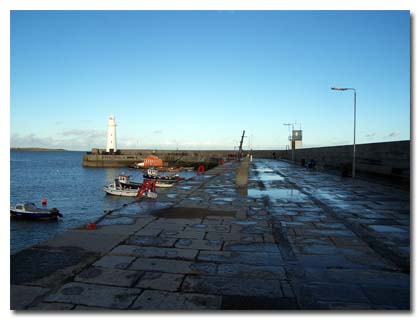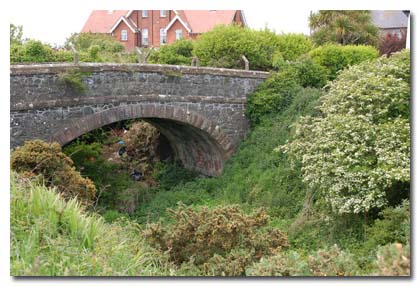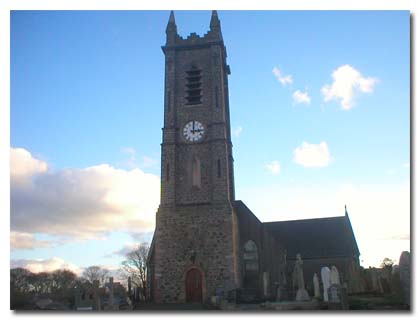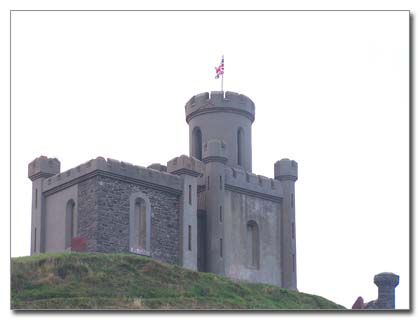 |
A Historical Walk Around Donaghadee
Donaghadee is a popular destination for visits, whether long or short. Many who make such visits pick up clues that there is more to the pleasant town and harbour than meets the eye – but are not sure how they can find out a little more about the place that might enrich the time spent there. This little guide hopefully will provide some information about various places in Donaghadee which be the answer, both to local people and visitors alike. Hopefully it will provide some answers and maybe highlight a little of what Donaghadee has to offer. It is designed to help its users to follow a route round the town and give them a little information about various points of interest, a little like a virtual Dander Round the Dee. If you fancy the real thing the summer of 2012 will have historical walks with this very title around the town with local historian Harry Allen on Thursday 26th July and Thursday 23rd August.
See here for details. |
A first, or even second-time, visitor will always be impressed by Donaghadee’s majestic harbour and wonder a little about its history. Well, the foundation stone for the current harbour in Donaghadee was laid in great ceremony on 1st August 1821 by the Marquis of Downshire. The initial plans and surveys for this ambitious undertaking were made by John Rennie Senior, the celebrated engineer whose works included other British and foreign harbours, canals and bridges over the Thames such as Waterloo, Southwark and London. He, however, died within two months of work beginning, and was succeeded by his son, John, later Sir John Rennie, who had as his resident engineer a fellow Scot, the seasoned marine builder, David Logan, who had assisted Robert Stevenson at the Bell Rock Lighthouse (1807–1810).The lighthouse dates from 1836 and a century later was the first one in Ireland to be converted to electric on the 2nd October 1934. The current harbour replaced its older and less useful predecessor in the 1830s.
As you walk along the South Pier of the harbour you will notice two parallel lines of cement running down to the crane. These are the only evidence of the railway lines that once carried imported coal to the local train station and on to Newtownards and Comber right up to 1950. The hand-turned crane is the only survivor of a pair that did the heavy lifting. A visitor might like to search for the keyhole-shaped piece of concrete that marks the spot where the other crane once stood.
Other clues to look for are at the tracks’ end where you can even see the holes where the buffers once stood, as well as smaller grooves which veer off the main track. These were created by wagons sometimes being derailed and digging into the limestone blocks of the harbour.
On the way towards the town from the harbour look for the stone steps on your right, opposite Pier 36. These are known locally as Kelly's Steps - a reference to a local coal importing business that once had a yard at the bottom of Manor Street which is on your left just past the steps. These are the only remaining part of the old harbour. If you look along the harbour wall towards these steps or from the steps towards the lighthouse you will notice the wall’s character changing from large limestone blocks to local stone. In line with this at extreme low tide you can see some rocks just protruding out of the sand. These are all that is left of the “old” pier where the Packet Boats sheltered before returning each day to Portpatrick.
Facing Kelly Step's is a building that is now the Meadowbank Social Club. This was formerly Donaghadee’s Railway Station. The railway lines ran from the back of this building, along what is now the Commons, and which is a now a public park. If you walk along here past the town’s new Community Centre and Bus Station you will come upon the Sir Samuel Kelly Lifeboat. Now gratefully retired, this vessel’s heroic moment came in January 1953, when her crew braved a fierce storm to go the aid of the stricken ferry, Princess Victoria, sinking off the Copeland Islands. The sinking of this Larne/Stranraer car ferry claimed more than 130 lives but the Kelly crew were able to save 33 of the ship's 44 survivors.
 |
Just past the Kelly and you will come to Copeland Marina. This is the site of the old Quarry Hole, from where the local dark greywacke stone was blasted before being used to form the back slopes of the present harbour.
If you carry on past the marina into the Commons, on your right you will see an impressive wall of the same blackish stone alongside Marine Drive. For a century this was the beginning of the boundary of the Donaghadee-Belfast railway line. As you walk along beside it you can easily spot clues that show where the trains would have run along here, before making their way into the railway cutting which is still visible further on along the Commons. If you follow the paths and continue up the hill you will see an old railway bridge at the top of the hill which can take you into Norwyn Avenue. This old bridge dates back to the building of the Donaghadee Line by the Belfast and County Down Railway in 1861. There was also a stop near here known as the Ballyvester Halt. As you approach Millisle Road you might like to try spotting marks in the grass which are probably all that remains of this Halt. |
Upon reaching the Millisle Road, a careful crossing will set you on the next piece of old track. A few minutes’ stroll will then take you to Hunt’s Park with its old Water Tower. The tower itself was constructed in 1912 by Donaghadee Urban District Council and is an early example of a reinforced concrete building. It provided Donaghadee's first mains water supply and remained in use until the 1940s. The tower itself is now closed, but the views from the hill are quite impressive, especially on a clear day.
A walk down the hill to the Killaughey Road and a right turn will take you back towards the town. Just after passing the town’s cricket pitch you will see Cafe Manor on your left. This is a pretty recent construction although sympathetically styled to fit in with its surroundings. Just behind the cafe sits what used to be the market garden for the Manor House, now a peaceful and attractive place which can be accessed through the cafe.
Facing you, at the end of the Killaughey Road, you will see the Admiral Leslie Hall which once belonged to the local Parish Church but is now the home of Donaghadee Baptist Church, It was built as a Free School in 1872 by Mrs. Martha Leslie in memory of her husband Rear Admiral Samuel Leslie. Just to its left, or your right, of the Church is Prospect House which dates from around the 1760s and beside it Rosebank House, once the residence of Rear Admiral Samuel Leslie. It is thought to be one of the oldest houses in Donaghadee and for many years lay almost derelict before the current owners spent many years lovingly restoring it. It was also the birthplace of Frances Elizabeth Bellenden Clarke who later used the pen name Sarah Grand to write what were then a number of controversial novels. She was also a active member of the Suffragette movement and was held in high regard by Mark Twain and George Bernard Shaw. She died in England on the 12th May 1943.
If you return to the Killaughey Road junction you will see the town’s Manor House on your right just a little further on. This was possibly the first large stone house built in the town after the arrival of Hugh Montgomery and his Ulster Scots settlers in the early seventeenth century. The family later became the Earls of Mount Alexander with their principal seat in Comber. Marie Angelique, the widow of the fifth and final Earl left the house on her death to members of her family in 1771 and their descendants have occupied the house ever since.
 |
If you continue down the slope of High Street you will find Grace Neill's bar on your left. Its date sign of 1611 announces that this is one of the oldest, if not the oldest bar in Ireland. It was formerly known as the Kings Arms and acquired its current name when a young Grace Neill was given the bar as a wedding gift in 1842 by her father. Grace ran the pub for an amazing seventy four years until her death in 1916. Because of the importance of the town’s Packet-Boat harbour, the bar has had a number of important visitors over the years, boasting such well-known names as writer Daniel Defoe, composer Franz Liszt, poet John Keats and even Peter The Great of Russia and a little later, the singer Tina Turner.
|
When the downslope of High Street bottoms out it becomes Moat Street at Donaghadee Methodist Church. This place of worship was supposedly built on this particular site because it was here that the Methodist Church's founder John Wesley once preached on one of his many visits to Ireland.
 |
. Just a short walk up this hill from here stands Donaghadee Parish Church. Shortly after Hugh Montgomery established his port at Donaghadee he erected the town’s first known Church in 1626, although it is thought that the building may have replaced an earlier stone church built by the Anglo-Norman John De Courcy who arrived in Ireland in 1176. The nearby townland of Templepatrick on the road to Millisle is believed to indicate that Ireland’s patron saint, Patrick, may have ministered for a time in the Donaghadee area as early as the sixth century, possibly with a resident priest named Daoi. After four centuries of colonization by mostly Scottish settlers, none of whom spoke Irish, it is impossible to be certain, but some believe that the name Donaghadee may derive from Domhnach Daoi meaning Daoi's Church.
The church’s stone tower was added in 1883 by Captain Daniel De Lacherois whose family also donated the bell, and if you look carefully you will see the difference in the stonework at the bottom of the tower compared to that farther up where the tower narrows. This is because the tower was possibly constructed on the remains of an ancient tower house which still retains its massive walls and arrow slits that suggest its earlier existence. Today’s church is surrounded by a graveyard. Its oldest headstone dates from 1660 and the whole plot is worth a walk round as many of the headstones are very interesting |
 |
From the Church, if you carry on up Moat Street you will see the great structure that is almost the icon of Donaghadee. This, of course, is "The Moat". On your right a small path will take you to the summit of this artificial hill from where one can see much of the town, and indeed, on a clear day, even County Antrim, Scotland, England and the Isle of Man. The hill or motte itself is of Anglo Norman origin dating from around the 13th Century. Its presence shows that the area has been an important haven for many centuries. The building on top dates from 1821 and surviving documents show that, although having the look of a folly, it was built as a powder magazine to store explosives during the building of the harbour.
An easy walk down the seaward side of the Moat takes you back to the Parade which will return you to your starting point at the harbour. |
|

